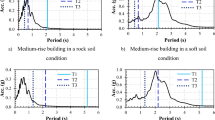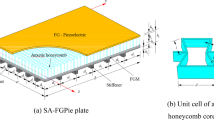Abstract
Structural pounding is one of the major reasons for severe structural damage or even collapse. Thus, detailed simulations, including dynamic contact formulations, are often required in order to obtain reliable response information of structures. This leads inevitably to computationally expensive analysis. Therefore, in this paper, an effective hierarchical substructure method, adapted to structural pounding problems, is introduced. Based on that, a hybrid substructure method is presented. Both strategies are presented on an academic multiple pounding example, applying both a sinusoidal and a real earthquake excitation. It is shown that both strategies enable accurate low-order representations of the complex full dynamic contact problem. Thereafter, the new approaches are compared with the classical modal truncation strategy and an improved controlled modal truncation strategy. It is shown that an extensive improvement of the approximation of the full response can be achieved applying the new hierarchical substructure and the new hybrid substructure approach.






















Similar content being viewed by others
References
Kasai K, Maison BF (1997) Building pounding damage during the 1989 Loma Prieta earthquake. Eng Struct 19:195–207
Pantelides CP, Ma X (1998) Linear and nonlinear pounding of structural systems. Comput Struct 66:79–92
Barbato M, Tubaldi E (2013) A probabilistic perfomance-based approach for mitigating the seismic pounding risk between adjacent buildings. Earthq Eng Struct Dyn 42:1203–1219
Chase GC, Boyer F, Rodgers GW, Labrosse G, MacRae A (2014) Probabilistic risk analysis of structural impact in seismic events for linear and nonlinear systems. Earthq Eng Struct Dyn 43:1565–1580
Tubaldi E, Freddi F, Barbato M (2016) Probabilistic seismic demand model for pounding risk assessment. Earthq Eng Struct Dyn 45:1743–1758
Jankowski R, Mahmoud S (2016) Linking of adjacent three-story buildings for mitigation of structural pounding during earthquakes. Bull Earthq Eng 14:3075–3097
Elwardany H, Seleemah A, Jankowski R (2017) Seismic pounding behavior of multi-story buildings in series considering the effect of infill panels. Eng Struct 144:139–150
Jankowski R, Mahmoud S (2015) Modelling of structural pounding. Earthquake-induced structural pounding. GeoPlanet: earth and planetary sciences. Springer, Cham
Anagnostopoulos AS (2004) Equivalent viscous damping for modeling inelastic impacts in earthquake pounding problems. Earthq Eng Struct Dyn 33:897–902
Jankowski R (2005) Non-linear viscoelastic modelling of earthquake-induced structural pounding. Earthq Eng Struct Dyn 34:595–611
Jankowski R (2006) Analytical expression between the impact damping ratio and the coefficient of restitution in the non-linear viscoelastic model of structural pounding. Earthq Eng Struct Dyn 38:1135–1142
Chau KT, Wei XX (2001) Ponding of structures modelled as non-linear impacts of two oscillators. Earthq Eng Struct Dyn 30:633–651
Muthukumar S, DesRoches R (2006) A Hertz contact model with nonlinear damping for pounding simulation. Earthq Eng Struct Dyn 35:811–828
Ye K, Li L, Zhu H (2009) A note on the Hertz contact model with nonlinear damping for pounding simulation. Earthq Eng Struct Dyn 38:1135–1142
Bhaskararao AV, Jangid RS (2006) Dynamic response of adjacent structures connected with friction dampers. Eng Struct 28:690–703
Patel CC, Jangid RS (2011) Dynamic response of adjacent structures connected by friction damper. Earthq Struct 2:149–169
Efraimiadou S, Hatzigeorgiou GD, Beskos DE (2013) Structural pounding between adjacent buildings subjected to strong ground motions. Part I: the effect of different structures arrangement. Earthq Eng Struct Dyn 42:1509–1528
Licari M, Sorace S, Terenzi G (2015) Nonlinear modeling and mitigation of seismic pounding between R/C frame buildings. J Earthq Eng 19:431–460
Ghandil M, Aldaikh H (2017) Damage-based seismic planar pounding analysis of adjacent symmetric buildings considering inelastic structure-soil-structure interaction. Earthq Eng Struct Dyn 46:1141–1159
Rega G, Troga H (2005) Dimension reduction of dynamical systems: methods, models, applications. Nonlinear Dyn 41:1–15
Kerschen G, Golinval JC, Vakakis AF, Bergman AL (2005) The method of proper orthogonal decomposition for dynamical characterization and order reduction of mechanical systems: an overview. Nonlinear Dyn 41:147–169
Bamer F, Bucher C (2012) Application of the proper orthogonal decomposition for linear and nonlinear structures under transient excitation. Acta Mech 223(12):2549–2563
Bamer F, Kazhemi AA, Bucher C (2017) A new model order reduction strategy adapted to nonlinear problems in earthquake engineering. Earthq Eng Struct Dyn 46(4):537–559
Bamer F, Markert B (2017) An efficient response identification strategy for nonlinear structures subject to nonstationary generated seismic excitations. Mech Based Des Struct Mach 45:313–330
Hurty WC (1965) Dynamic analysis of structural systems using component modes. AIAA J 3:678–684
Craig RR, Bampton MC (1968) Coupling of substructures for dynamic analyses. AIAA J 6:1313–1319
MacNeal RH (1971) A hybrid method of component mode synthesis. Comput Struct 1:581–601
Rubin S (1975) Improved component-mode representation for structural dynamic analysis. AIAA J 13:995–1006
Rixen DJ (2004) A dual Craig–Bampton method for dynamic substructuring. J Comput Appl Math 168:383–391
Sridhar A, Kouznetsova VG, Geers MGD (2016) Homogenization of locally resonant acoustic metamaterials towards an emergent enriched continuum. Comput Mech 57:423–435
Batou A, Soize C (2009) Identification of stochastic loads applied to a non-linear dynamical system using an uncertain computational model and experimental responses. Comput Mech 43:559–571
Ezvan O, Batou A, Soize C (2015) Multilevel reduced-order computational model in structural dynamics for the low- and medium-frequency ranges. Comput Struct 160:111–125
Ezvan O, Batou A, Soize C, Gagliardini L (2017) Multilevel model reduction for uncertainty quantification in computational structural dynamics. Comput Mech 59:219–246
Ohayon R, Sozie C (2014) Clarification about component mode synthesis methods for substructures with physical flexible interfaces. Int J Aeronaut Space Sci 15:113–122
Li G (2008) A multilevel component mode synthesis approach for the calculation of the phonon density of states of nanocomposite structures. Comput Mech 42:593–606
Lim SP, Liu AQ, Liew KM (1994) Dynamics of flexible multibody systems using loaded-interface substructure synthesis approach. Comput Mech 15:270–283
Zucca S (2017) On the dual Craig–Bampton method for the forced response of structures with contact interfaces. Nonlinear Dyn 87:2445–2455
Starc B, Cepon G, Boltezar M (2017) A mixed-contact formulation for a dynamics simulation of flexible systems: an integration with model-reduction techniques. J Sound Vib 393:145–156
Wriggers P (2006) Comput Contact Mech, 2nd edn. Springer, Berlin
Chopra AK (2007) Dynamics of structures, theory and applications to earthquake engineering, 3rd edn. Prentice Hall, Upper Saddle River
Kobe Takarazuka earthquake measurement 1995-01-16(UTC: 20:46:52), ath.KOBE.TAZ000.AT2. (2016) Strong Motion Virtual Data Center (VDC). www.strongmotioncenter.org
Saint-Venant AJCB (1855) Memoire sur la Torsion des Prismes. Mem Divers Savants 14:233–560
Love AEH (1927) A treatise on the mathematical theory of elasticity. Cambridge University Press, Cambridge
Author information
Authors and Affiliations
Corresponding author
Rights and permissions
About this article
Cite this article
Bamer, F., Shi, J. & Markert, B. Efficient solution of the multiple seismic pounding problem using hierarchical substructure techniques. Comput Mech 62, 761–782 (2018). https://doi.org/10.1007/s00466-017-1525-x
Received:
Accepted:
Published:
Issue Date:
DOI: https://doi.org/10.1007/s00466-017-1525-x




